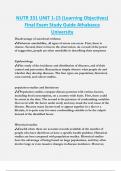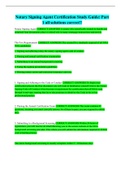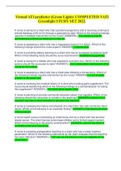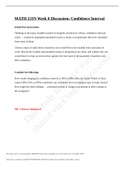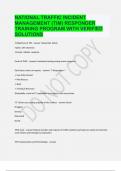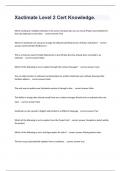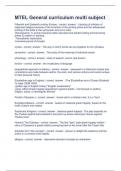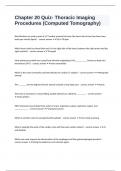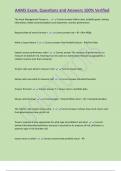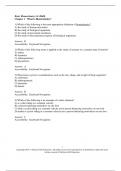Final Exam Study Guide Athabasca
University
Disadvantage of anecdotal evidence
✔✔inherent unreliability, all types of errors can occur. First, there is
chance. Second, there is bias in the observation. As a result of the power
of suggestion, people are often unreliable in describing their symptoms
Epidemiology
✔✔the study of the incidence and distribution of diseases, and of their
control and prevention. Researchers simply observe what people do and
whether they develop diseases. The four types are population, historical,
case-control, and cohort studies.
population studies and limitations
✔✔Population studies compare disease patterns with various factors,
including food consumption, on a country-wide basis. First, there could
be errors in the data. The second is the presence of confounding variables
that occur with the factor under study and may mask the real cause of the
disease. Because many factors tend to appear together in a diet or a
lifestyle, it is quite easy for some confounding variable to be the culprit
instead of the identified factor.
Historical studies
✔✔useful when there are accurate records available of the number of
people who have died from or have a specific health problem. Historical
studies are best compared with population studies. Historical studies
have the advantage of being based on large populations, and they often
involve large or even massive changes in disease incidence. However,
,disease statistics collected 60 or more years ago can often be unreliable. A
more important disadvantage is that confounding variables often give rise
to spurious relationships.
case-control
✔✔recruitment of subjects and data collection are done after the disease
has developed. Two groups of subjects are recruited, one consisting of
individuals suffering from the disease of interest, and the other (the
control group) free of the disease. As the data are collected after the
disease has developed, case control studies are sometimes known as
retrospective studies.
Cohort
✔✔a large number of healthy subjects are recruited. They are questioned
or examined to determine each person's exposure to the particular factors
under study (24 hr recall or food frequency). The investigators then keep
track of the subjects over time until enough of them have developed the
disease of interest. The investigators then compare those who developed
the disease to those who did not, particularly with respect to exposure to
the possible disease-causing factors.
Advantages of case control and cohort studies
✔✔Case control are cost effective and cohort studies allow you to
examine multiple outcomes for a single exposure.
Disadvantages of case control and cohort studies
✔✔They both are prone to recall bias with the use of 24 hour recall and
food frequency questions
,Animal Experiments
✔✔Helps with investigating the causes of disease. researchers will
investigate the effects of different treatments on disease occurrence or on
some other parameter relevant to health. The researcher will divide the
animals into groups. Each group will receive a different treatment. A
control group will receive no treatment. At the end of the experiment, the
animals will be examined to determine the effect of the treatment.
✔✔
two major advantages over conducting experiments on humans
✔✔First, Animal experiments can be carefully controlled. Thus, there is
very little difference between the experimental groups other than the
experimental variable under study. Second, animal experiments permit
testing of chemicals at potentially toxic levels, allowing researchers to
examine the effects on various tissues postmortem.
Animal experiments drawbacks
✔✔The principal drawback is that the results from experiments on
animals may not apply to humans
Laboratory Studies
✔✔examine the biochemical and physiological mechanisms that lie
behind the disease.
Assess nutrition information for reliability
✔✔It is important to have a healthy level of skepticism with nutrition
information found in the media, books, or websites. You are encouraged
to check for the credentials of the nutrition expert. As no single study is
, completely reliable, look for reproducibility and consistency (criteria for
basing facts in nutritional studies)
Describe the goals of Dietary Reference Intakes (DRI)
✔✔1) Facilitate nutrition research and policy (EAR) 2) Preventing
chronic diseases (AMDR) 3) Setting safety guidelines (TUL) 4) Setting
recommended intake values (RDA and AI)
Estimated Average Requirements (EARs)
✔✔are used by nutrition and health professionals to plan group diets
(e.g., daycares, seniors' lodges) and for assessing the adequacy of a
population's diet.
Acceptable Macronutrient Distribution Ranges (AMDR)
✔✔are established for the energy-giving nutrients (also called
macronutrients). The ranges are designed to lower the risk of chronic
disease
Energy Requirements (EER)
✔✔Energy recommendations are based on average needs, rather than the
highest needs. They don't want it to be too high to encourage overeating
DRIs are designed for
✔✔people of all ages. They are separated into 18 age-gender categories,
plus five categories for stages of pregnancy and lactation. They are
technical guidelines describing nutrients that are used to assess diets and
provide nutrition advice.

